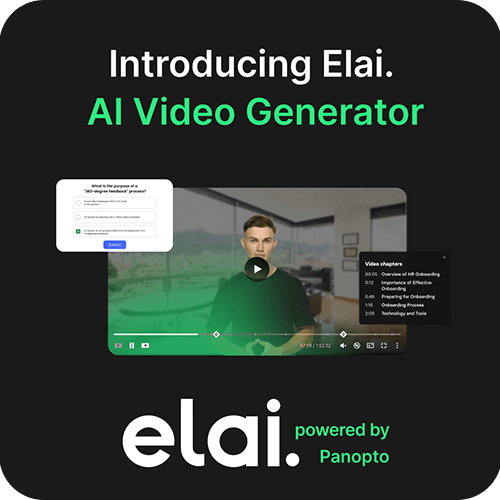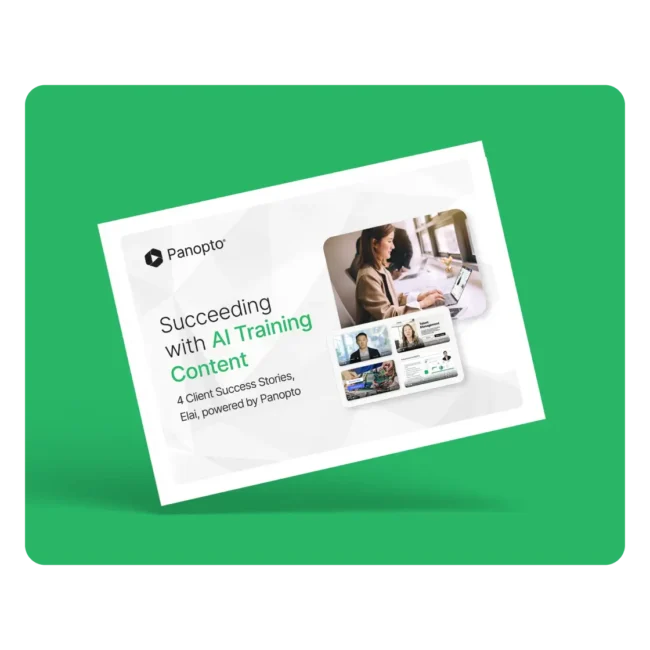- Training
Competency-Based Learning: A Game-Changer for Enterprise Training

In the fast-paced business world, staying ahead means having a workforce that can adapt quickly to new challenges. Competency-based learning (CBL) has become a vital strategy for developing a skilled workforce that can quickly adapt to evolving needs and challenges. This learning model focuses on ensuring that learners, regardless of career stage, demonstrate mastery of critical competencies required for their roles. Unlike traditional time-bound training programs, CBL prioritizes skills over seat time, enabling a more personalized and efficient approach to employee development.
The rise of video-enabled training has significantly enhanced the effectiveness of CBL in the corporate world. Video technology, like Panopto, allows businesses to deliver engaging, flexible, and scalable learning solutions that align with the demands of modern work environments.
What is Competency-Based Learning in the Enterprise?
In an enterprise context, competency-based learning zeroes in on specific job-related skills and knowledge that employees must demonstrate before advancing. This approach is particularly valuable in industries where staying current with technology, compliance standards, and business processes is essential for success. For instance, in IT, employees might need to master certain programming languages before taking on more advanced projects. In sales, proving proficiency in CRM software could be a stepping stone to handling bigger accounts.
Unlike traditional training models structured around a set number of training hours or modules, competency-based learning ensures that every learner reaches the required level of competency at their own pace, focusing on outcomes rather than time spent in training sessions.
The Role of Video in Competency-Based Learning for Business
Video technology plays an important role in delivering and supporting competency-based learning in business. Here are 4 ways video transforms corporate learning programs:
- Asynchronous Learning for Busy Professionals
One of the biggest hurdles in corporate training is accommodating the schedules of busy professionals. Video content allows for asynchronous learning, so employees can access training materials whenever it suits them—during a break, after work, or while traveling.
Research shows that 94% of organizations agree that video training allows for more flexible learning schedules than traditional, in-person training sessions.
Platforms like Panopto enable organizations to create on-demand training libraries where learners can watch, pause, replay, and review videos until they fully comprehend the content. This flexibility ensures that employees can achieve mastery of a skill before moving forward. For example, when a company rolls out new software, video tutorials can help staff get up to speed. Employees can watch and learn at their own pace, making it easier to retain information and apply it effectively.
- Bringing Job-Specific Skills to Life
Many enterprise jobs often involve complex tasks that are difficult to convey through traditional text-based training. Video is an effective medium for demonstrating specific competencies, especially those requiring hands-on skills.
For instance, in the manufacturing industry, a video tutorial can show how to operate specialized equipment step-by-step, making it easier to see exactly how a task is performed. In customer service, a video might demonstrate best practices for handling difficult customer interactions, providing employees with real-world scenarios.
Additionally, Video-based skills assessments allow employees to record themselves demonstrating key competencies—whether technical skills, sales pitches, or leadership techniques. Managers or trainers can then evaluate these recordings, providing a more authentic way to assess employee skills than written exams.
- Scaling for a Global Workforce
One of the major advantages of using video in corporate training is the ability to scale learning programs across a large, geographically dispersed workforce. Businesses no longer need to bring employees to a central location for training; instead, they can create video content accessible to learners anywhere in the world.
This is particularly valuable for multinational companies that must ensure consistency in training across offices in different regions. Video delivers a consistent learning experience and ensures that every employee receives the same quality of instruction, no matter where they are located. It also makes it easier to onboard large numbers of employees quickly.
Platforms like Panopto can break down barriers to global learning with a multilingual video platform featuring automatic speech recognition (ASR) captioning and real-time translation for 20+ languages. This empowers learners of all backgrounds, learning styles, and linguistic preferences to access the knowledge they need on their terms.
- Streamlined Feedback and Continuous Assessment
Competency-based learning requires continuous assessment to ensure learners develop and demonstrate the required competencies. Video technology makes it easier for managers and trainers to provide personalized feedback throughout the learning process.
For instance, employees might submit video recordings of their work—such as a product demo or a technical procedure—for review. Managers can then offer specific, time-stamped feedback, allowing employees to understand exactly where improvements are needed. This real-time, visual feedback loop is far more effective than traditional written evaluations, particularly when assessing performance-based skills.
Video-based assessments also allow companies to track progress over time, providing insights into which employees have mastered certain competencies and which may need additional support. Platforms like Panopto offer analytics that help businesses monitor employee engagement, progress, and outcomes.
Benefits of Video-Enabled CBL for Enterprises
Video-enabled competency-based learning offers numerous benefits for businesses looking to upskill their workforce and remain competitive in an ever-changing market:
- Increased Employee Engagement
Video content is far more engaging than traditional text-based training methods. Employees are more likely to stay engaged with dynamic content that includes real-world demonstrations, interactive elements, and the ability to control their learning experience. Additionally, engagement analytics features can provide valuable insights to trainers.
- Cost-Effective and Time-Saving
Video-based learning can significantly reduce the costs associated with training, particularly when it comes to travel and in-person instruction. In fact, companies using video for learning are 40% more likely to save money on overall training expenditures. Once a video is created, it can be reused across multiple cohorts of employees, reducing the need for repeated live training sessions. Furthermore, video enables remote assessments, saving both time and resources while maintaining the quality of competency evaluations.
- Improved Skill Retention and Mastery
Video allows learners to review content multiple times and at their own pace, promoting better skill retention. Employees can move quickly through areas they understand well while spending more time on challenging competencies, ensuring mastery before advancing.
Video Training Applications in the Enterprise
Many industries are already leveraging video-enabled CBL to improve workforce training and development. For example, companies in the financial services sector are using video to train employees on compliance regulations, ensuring they demonstrate a thorough understanding before handling sensitive customer data.
In the healthcare industry, competency-based learning through video helps staff and physicians stay current with changing standards of care, evolving processes, and the latest compliance requirements, enabling streamlined and consistent patient care delivery.
Challenges and Future Outlook
While the benefits of video-enabled competency-based learning are clear, some businesses may consider competency-based learning to be daunting. After all, the need to produce sufficient video content to feed an expanding video training library while balancing production standards and cataloging techniques is no small task. Embracing the progress, not perfection mantra, consider:
- Video captured using a mobile phone is fine. In fact, some video platforms have mobile apps designed to optimize and render high-quality mobile videos.
- Keep it short. The optimal duration for training videos is 11-15 minutes, aligning with current micro-content standards.
- Above all, be timely and accurate. Companies that rely on video-based learning are 39% more likely to provide employees with timely information than those not using video-based learning.
Looking ahead, advancements in artificial intelligence will likely further enhance video-based competency learning, allowing learners to find the training content they need more easily. These technologies will unlock personalized learning, enhance content discovery and reference-based learning, and bring a new level of scale to competency-based learning. By focusing on skill mastery and leveraging the power of video, businesses can create a more flexible, engaging, and effective learning environment that meets the demands of the modern workplace.
Latest News
-

- Training
Core Competency Training Guide: Transforming Organizational Expertise into Competitive Advantage
Core competency training empowers organizations to harness their unique strengths and turn them into competitive advantages. This separates market leaders from the pack. By strategically identifying and developing these distinctive organizational capabilities, companies create the foundation for sustainable growth and market differentiation that competitors simply cannot replicate. This guide will walk you through implementing practical…
Core Competency Training Guide: Transforming Organizational Expertise into Competitive Advantage
-

- Onboarding
Onboarding Solutions That Drive Engagement
Onboarding solutions set the tone regarding how companies welcome new employees. Modern approaches dramatically boost productivity and retention rates. Yet many organizations still use outdated methods that frustrate and disengage new hires. This gap between expectations and reality creates an opportunity. Smart solutions turn a tedious process into a strategic advantage. New employees need more…
Onboarding Solutions That Drive Engagement
-

- Healthcare
E-learning for Healthcare Guide
E-learning for healthcare has revolutionized medical education. Educators are no longer relying solely on classroom training and printed materials. Healthcare organizations face intense pressure to deliver quality training with limited resources. Now, e-learning offers the perfect solution. It transforms how medical professionals stay current with evolving knowledge and practices that save lives. The strategic implementation…
E-learning for Healthcare Guide



